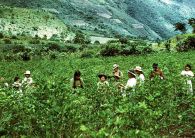 A survey conducted by the National Commission for Development and Life without Drugs, Devida, and the Lima-based Calandria Institute, shows that a majority of people in four of Peru’s coca growing departments acknowledge that the leaf’s primary function is to fuel the cocaine trade.
A survey conducted by the National Commission for Development and Life without Drugs, Devida, and the Lima-based Calandria Institute, shows that a majority of people in four of Peru’s coca growing departments acknowledge that the leaf’s primary function is to fuel the cocaine trade.
The survey was conducted in December 2007 in the Ayacucho, Huanuco, San Martín and Ucayali departments and published Monday in Peru’s main daily newspaper, El Comercio. Four hundred people from each department were interviewed.
The survey found that 63.5 percent of the people recognize the main use of the coca leaf was for cocaine, while 66 percent confirm that drug traffickers use extortion and threaten coca growers, known as cocaleros, in order to increase coca leaf production.
The majority of the population is aware of social problems associated with the cocas illegal cultivation and the presence of drug traffickers, the study showed. Forty-two percent of those surveyed say crime, theft, and extortion are the main problems from illegal coca cultivation while 59.8 percent say the increase in crime is the main problem from drug trafficking.
More than 80 percent of the population confirmed that adolescents are the main drug runners used by traffickers from the Peruvian jungle to the coast.
Drug trafficking and terrorism expert, Jaime Antezana, told daily El Comercio the survey reveals two important changes in the population’s perception:
The first change is that the majority believe the coca leaf’s main use is for cocaine production. “This ascertainment discredits the cocalero discourse and those in favor of coca that tried to convince the country that the coca they defended in the valleys were for medicinal and religious use, to sell it to Enaco, for traditional or industrialized consumption,” says Antezana. “These results reveal that the population understands very well the difference between legal coca and illegal coca.”
The second change is a new attitude towards the illegal cultivation of coca, which supports an overall reduction of illegal coca.
“But the most surprising thing of this study,” says Antezana “is that there is an important sector of the population that agrees with the ‘total elimination of coca cultivation … 11.3 percent in Ayacucho, 28 percent in Huanuco, 24.5 percent in Ucayali and an impressive and surprising 50 percent in San Martín.”





